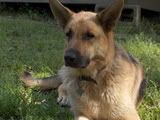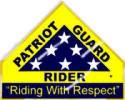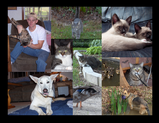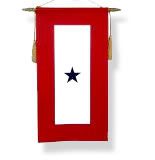SPECIAL BOND
A story worth reading...
Staff Sgt. Iron quakes with fear at the sound of explosions. He brawls with other soldiers. He whines when he doesn't get his way and slows others down when he stops to relieve himself during patrols through hostile territory.
But nobody complains, because when it's time to enter a building that might be rigged to explode, or cross a pasture that could conceal a minefield, Iron is at the front of the line, making sure it's safe for those who follow.
If it's not, Iron will bear the brunt of the blast, along with his best friend, Sgt. Joshua T. Rose, who ranks one level below him. It's an honor Iron enjoys for the dangerous job he does. It also ensures that charges could be filed against Rose in the unlikely event he ever mistreated Iron -- an 80-pound German shepherd.
Rose and Iron are one of about 200 canine teams deployed in Iraq, where the bond between soldiers and their dogs is so deep that some handlers have asked to be buried with their canine partners if they are killed together.
On frigid winter nights in the Iraqi desert, Rose shares his cot and sometimes his sleeping bag with Iron to keep him warm. In the scorching summer heat, he makes sure Iron has enough water before taking his own share. If the heat is too much for Iron, who has a thick coat of glossy black fur, Rose lets him rest, no matter what the platoon leader might want.
Whenever he goes on a mission, Rose tucks a copy of an ode to police and military dogs into his front pocket. It reads in part: "Trust in me, my friend, for I am your comrade. I will protect you with my last breath. When all others have left you and the loneliness of the night closes in, I will be at your side."
"These dogs are like our children. I'm closer to my dog than I am to anyone other than my wife," said Staff Sgt. Charles W. Graves, the kennel master at Forward Operating Base Kalsu, about 20 miles southeast of Baghdad.
Graves works with Udo, a yellow Labrador retriever who holds the rank of sergeant 1st class, one higher than Graves. He is the fifth dog Graves has been teamed with.
Graves adopted his first dog after it retired from active duty. The dog died at age 16, from a heart attack while chasing a cat.
His fourth dog was aggressive and liked to bite, nothing like Udo, who is a specialized search dog. That means he isn't aggressive and can run off his leash, wearing a vest that holds a radio through which Graves issues commands.
"If something ever happened to him, I'd never work canine again," Graves said as Udo did a practice run across a field dotted with remnants of once-lethal explosives and other weapons.
Handlers are expected to keep their dogs "on odor" by putting them through such training every month, to ensure they don't lose the ability to detect TNT, C4, AK-47s, wires, metal and the other threats that insurgents have planted across Iraq.
"If they took him out, I'd kinda wish they'd take me out too," Graves, a former police officer from Oroville, Calif., said as Udo loped nearby. With each successful find, Udo was rewarded with a toss of his favorite toy, a rubber cone.
"It's a helluva thing, owing your life to a dog," Graves said.
Before each deployment, troops are asked to update their wills. Graves included a request to be buried with Udo should they die together. It has happened before. Last July, Cpl. Kory D. Wiens, 20, and his Labrador retriever, Cooper, became the first soldier-dog team killed since Vietnam. They were buried side by side in Wiens' hometown of Dallas, Ore.
If you spend time with the soldier-dog teams, it becomes clear that the key to being a successful canine handler is to love dogs and to adapt to their childlike needs.
"If you deal well with kids, you'll deal well with dogs," said Rose, who has a husky and a dachshund back home in Kansas. "You're working with about a 3-year-old mentality."
Navy Petty Officer 2nd Class Blake T. Soller knows that all too well. Last April, his 4-year-old dog, Pluto, couldn't resist leaping over the side of a cargo ship into New York Harbor, 60 feet below. Soller jumped in after Pluto and stayed with the 87-pound Belgian Malinois until a Navy boat picked them up. Neither was injured.
The U.S. military has used dogs in combat zones since World War II and deployed about 4,300 to Vietnam between 1965 and 1973.
















2 comments:
Awesome post.
My grandfather raised and trained a Doberman who was used in the Marine Corps during WWII. "Red" was killed in action during an ambush, and the write up in the local paper that my mom remembers said that Red died protecting his Marines, and he attacked the enemy which gave the Marines a chance to escape the ambush at the cost of Red's life.
I am currently researching what I can about Red. The databases are sketchy and not all dogs and their service are recorded. I am hoping to get to Ohio this summer so that I can look through the public archives and find the original article -- then I can unravel some more of the story.
Post a Comment